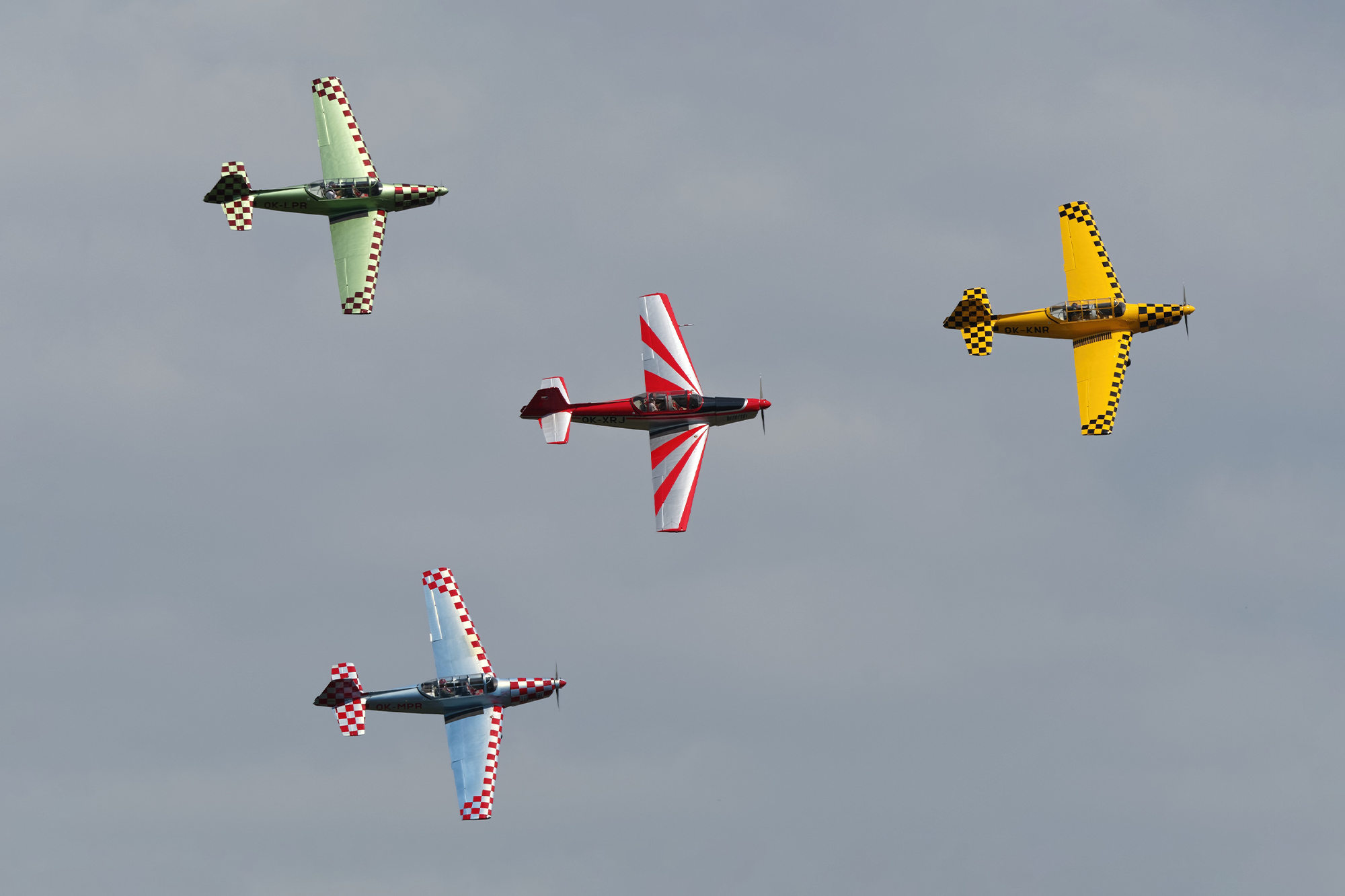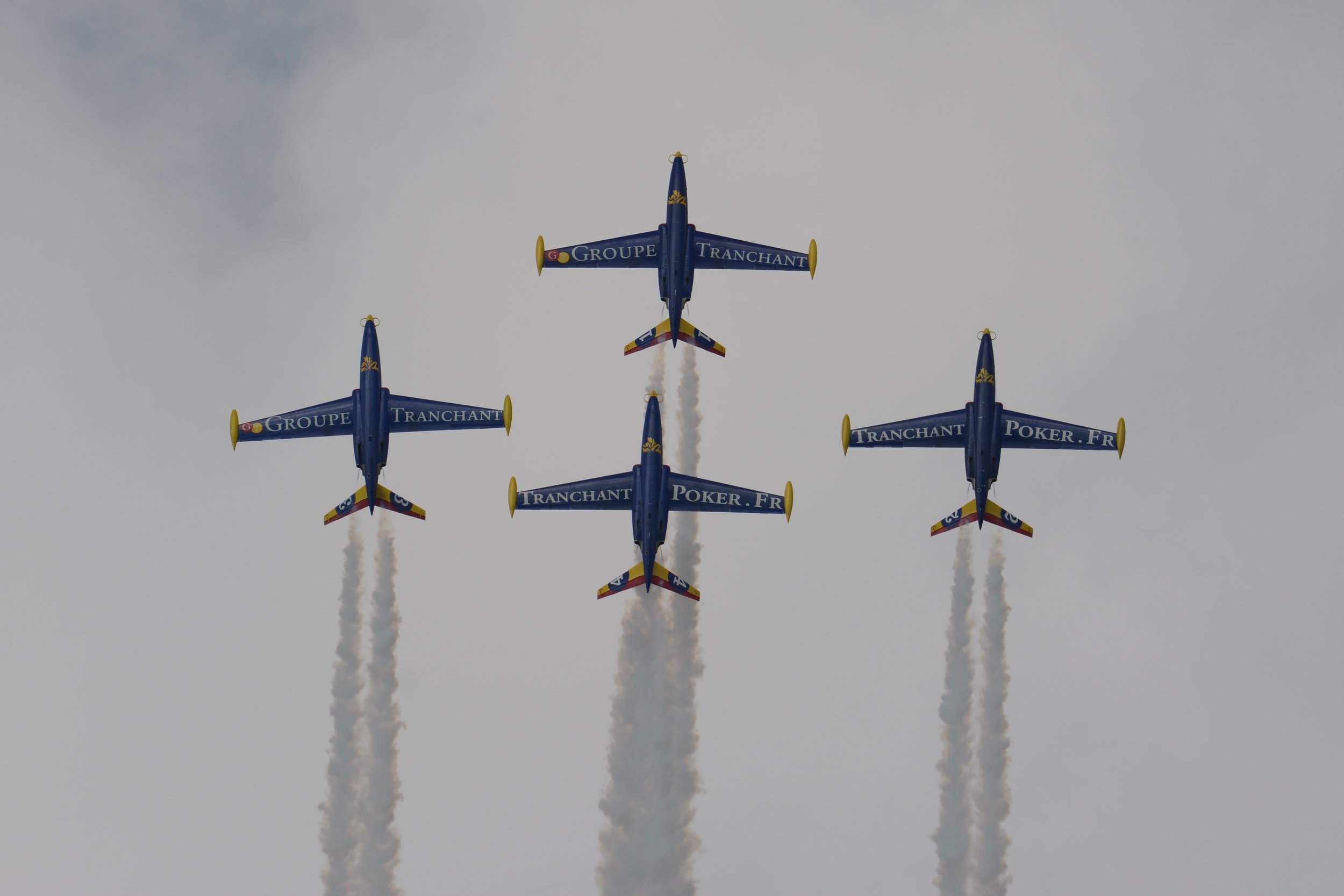Global Stars
Country
UK
Size
4 Aircraft
Base
Little Gransden Airfield
The Global Stars, renowned for their thrilling aerobatic displays, are based at the Little Gransden Airfield in Cambridgeshire, England. Apart from wowing audiences at various British airshows, the team has showcased their talents across Europe, China, India, and Australia. Audience favourites include their precise four-ship formation aerobatics, breathtaking opposition passes, and jaw-dropping spectacular breaks. Notably, their performance staple is the visually stunning double heart manoeuvre. The team also performs stunning night-time pyro displays with wingtip-mounted pyrotechnics, creating a mesmerizing and unforgettable spectacle that dazzles the audience in the dark sky.
| Back to Top |
Extra 330SC
The Extra 330SC is a Lycoming AEIO-580-powered single-seat aircraft with improved roll rate and easier roll stops, designed specifically for Unlimited category competition.
The design of the Extra 300 was based on the Extra 230, an early 1980s monoplane having a wing made of wood. The Extra 300 has a welded steel tube fuselage covered in aluminium and fabric. The midset wing has a carbon fibre composite spar and carbon composite skins. A symmetrical airfoil, mounted with a zero angle of incidence, provides equal performance in both upright and inverted flight. The landing gear is fixed taildragger style with composite main legs and fibreglass wheel pants. The powerplant is a Lycoming AEIO-580 EXP which produces 325 horsepower.
The Extra 300 is stressed for ±10 G with one person on board and ±8 G with two. Some Extra 300s are certified in the experimental category in the U.S., while others are certified in the aerobatic category
| Back to Top |
Extra 300S
The Extra 300S is a single-seat version of the original two-seat Extra 300 with a wingspan reduced by 50 cm and fitted with larger ailerons.
| Back to Top |
Extra 200
The Extra 200 (Type EA-200) is a two-seat, tandem arrangement, low-wing aerobatic monoplane with conventional (taildragger) landing gear fully capable of Unlimited category competition, built by Extra Flugzeugbau.
Designed by Walter Extra, it was introduced to the United States market in 1996. The Extra 200 is slightly smaller than the Extra 300 and is powered by a 200 hp (149 kW) rather than the Extra 300's 300 hp (224 kW) Lycoming engine making it a great choice for those on a restricted budget. It offers the flying characteristics of the EA-300, is capable of all unlimited manoeuvres, and makes a great all-around training/sports aerobatic aircraft.
The Extra 200 is based on the design of the Extra 300, and the two aircraft share many similarities. The Extra 200 has a welded steel (4130) tube fuselage covered in fibreglass and fabric with a carbon/glass hybrid composite empennage (i.e., the tail assembly, including the horizontal and vertical stabilizers, elevators, and rudder), and a bubble canopy. The monocoque wings have a carbon fibre composite spar with fibreglass skins and an integral fuel tank. A symmetrical airfoil, mounted with a zero angle of incidence, provides equal performance in both upright and inverted flight. The landing gear is fixed taildragger style with composite main legs and fibreglass wheel pants. The piston-engined powerplant is a fuel-injected Lycoming AEIO-360-A1E that produces 200 horsepower (149 kW), and it is equipped with a 3-bladed constant-speed MTV-12-B-C/C 183-17e propeller made of laminated wood encased in glass-fibre reinforced plastic. The Extra 200 is stressed for ±10 G with one person on board and ±8 G with two and has an FAA certified load factor in the US to ±10 G.
| Back to Top |
Mudry CAP 232
The CAP Aviation CAP-23x family is a family of aircraft designed for competition aerobatics. The CAP 230 airframe was a direct development of the CAP 21 competition single seater strengthened to cope with a 300 hp 6-cylinder Lycoming AEIO-540 engine instead of the 200 hp original 4-cylinder Lycoming AEIO-360. The CAP 230 was primarily developed in 1985 for the French Air Force. From the basic CAP 21 airframe, trailing edge apex triangular surfaces were added to the basic trapezoidal wing and full wooden construction. It withstood +10/-10 G-forces, had a 270 degrees/second roll rate and a top speed of 400 km/h. Between 1986-1990 this was the mount of the French Air Force aerobatics team (French: Equipe de Voltige de l'Armée de l'Air). The CAP 231 was developed in 1990. The fuselage design remained unchanged and only leading-edge triangular apex surfaces were added to reduce buffeting during high G pullups. The CAP 231 was the world champion in 1990. Between 1990-1998 this was the mount of the French Air Force aerobatics team. To increase performance, in 1991, a carbon-fibre wing taken from an EXTRA 260 (thus the -EX name) was adapted to a few CAP 231 airframes. The CAP 231EX evolved in 1994. While the fuselage construction retained wood, a carbon-fibre wing was specially designed for durability and lightweight. The design has won the World Championships in 1998, 2000 and 2007, as well as a number of other national-level competitions. It has a roll rate of 420° per second and a climb rate of nearly 3,300 feet per minute. The CAP 232 just like the -230 and -231/-231EX were slightly modified to strengthen the fuselage structure after a fatal accident in 2005 which grounded them for a full year. Fuselage rib n°2 holding the landing gear and the wing spar has been reinforced externally and internally. The planes are now back to competition and came second (individual with a -231EX), sixth with a -232, and first-team at the WAC 2007. In the years 1999-2005, examples were flown by the French Air Force aerobatics team.
| Back to Top |








| Back to Top |

































